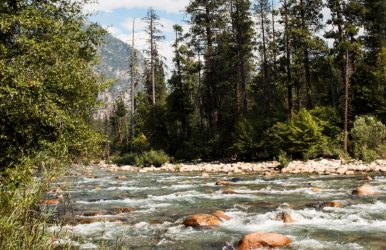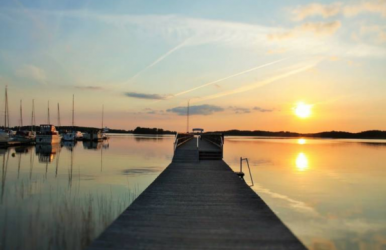A Guide To The Scenic Drives In Kings Canyon National Park
BY Sibashree Aug 29, 2024
Kings Canyon National Park is as grand as its name as it has to offer the most versatile landscape. The granite walls, the flowing streams, and the rugged terrain make it a paradise for hikers and geology enthusiasts. However, with its diverse vegetation of pine trees, grass, and sequoias, the park is also known for its unique driving experience. The rocky roads with the embrace of green trees are surely worth exploring if you want to make memories for a lifetime. So, if you are a national park freak and want the most memorable experience, your road should lead to the Kings Canyon Scenic Byway. Kings Canyon National Park Scenic Drive (Kings Canyon Scenic Byway) As you drive on the main Highway 180 and turn to the east, you will find the Kings Canyon Scenic Byway stretch. The first stoppage along the stretch will be the Junction View. From Junction View, you can have a panoramic view of the Middle and South Forks of the Kings Canyon. The Kings River carving its way through the landscape makes the view unbelievable. Your journey can continue till the late afternoon, and Knapp’s Cabin will be the final major highlight of your scenic drive. The table below will give you a brief overview of what the scenic drive along Kings Canyon Drive is going to look like. Highlights Things to Do Cedar Grove Drive east from the road to reach the Kings River. From there, go to the Cedar Grove Visitor Center and gather information about the park trails. You can grab your quick lunch at the facility stores here. Canyon Viewpoint Behold the gigantic granite rocks and the U-shaped formations. Look at the nearby pine trees. Zumwalt Meadow Trail (Hiking) This is a short and power-packed hiking trail. Bridge over the Kings River Enjoy the scenic views and take pictures from the bridge. Arriving at Zumwalt Meadow The Zumwalt meadow looks like the most picturesque painting. Behold the green grass, dark pine trees, and rocky walls made of monolithic granite stone. Beware of mosquitoes and bugs here, and use repellants. Following the Trail along the River Maintain a decent pace while walking through the trail along the river, and thus, you will reach the other side of the Zumwalt meadow. Explore the Rocky Side of the Loop Explore the unique and gigantic rock formations on this rocky side. The calm meadow here offers an immersive experience. Relax by the Knapp’s Cabin This cabin tells you the tales of George Knapp, who built this cabin in 1925. It can be a nice escape for clicking pictures and playing hide and seek. Once you are done exploring the Kings Canyon National Park, you can come back to the Kings Canyon scenic byway. Behold the changing colors of the afternoon there and click the most mesmerizing photographs. Other Things To See In Kings Canyon National Park As the name suggests, the Kings Canyon National Park offers you the most majestic experience. The moment you enter the park at the Big Stump Entrance, you will find the Big Stump Picnic Area, and from there, you can start exploring the big stumps in the park along the Big Stump Trail. The jungle of old pine trees and the magnificent sequoia trees will offer you the most quaint experience. You will feel humbled by the presence of these towering trees. However, the Mark Twain Stump is the biggest highlight of this trail. This gigantic stump has stairs so that you can climb to the top. Once you have visited the Mark Twain Stump, you can take up the following ventures. Visit The Grant Grove Village From the Big Stumps Trail, you must make your journey toward the Grant Grove Village. There, you will find the Kings Canyon Visitor Center. You will meet rangers at this visitor center and find the best recommendations about your journey in the national park. Once you know the hiking points and the highlights of the park and have a hiking map handy, you are all set to make the most of the national park. The rangers will also guide you with instructions about the routes to be avoided for a particular season. Hike Through The General Grant Loop Trail As the name suggests, the General Grant Loop Trail is filled with gigantic trees. You can take a peaceful walk here. Keep Walking Through The Fallen Monarch A giant fallen sequoia tree with a hollow trunk is known as the Fallen Monarch. It is fun to play around with the hollow trunk, and you can use it as a shortcut to connect two sides of the General Grant Loop. Meet The General Grant Tree The 1700-year-old General Grant Tree is surely the pride of the Kings Canyon National Park. The massive scar at the bottom of the tree trunk gives it a gothic appearance, and it shows how the tree has survived extreme weather conditions throughout the years. Nevertheless, it’s great to find the “Nation’s Christmas Tree” in a magnificent condition despite the ravages of time. Did You Know? The General Grant Tree was designated as a “National Shrine” in 1956. President Eisenhower declared it a National Shrine to commemorate men and women in the USA armed forces. It is the only living “National Shrine” in the USA. Visit The Hume Lake If you are in for an immersive experience, don’t forget to spend your time by the Hume Lake. This mountain lake is known for its pristine beauty and green water. The pine trees and unique rock formations surrounding the lake make it appear all the more special. The Hume Lake is one of the least visited places in Kings Canyon National Park. So, keep the park map handy so as to not miss the beauty of the lake. Relax At The Gamlin Cabin The Gamlin Cabin, built by Israel Gamlin, was once used as the U.S. Cavalry storehouse. This wooden cabin with a stone fireplace inside has a quaint appeal. After catching your breath at Gamlin Cabin, you must continue walking along the trail. At the end of the trail, you will find the other side of the Fallen Monarch tree trunk. The hollow trunk of the tree is a favorite of kids and young adults for some mischievous activities. From here, you can plan other activities in the national park or get back on the main road 180. Final Words: Is Kings Canyon Worth The Trip? With magnificent sequoias, colossal rock formations, and many trails, the Kings Canyon National Park is a favorite of outdoor enthusiasts. Further, a drive through the Kings Canyon Scenic Byway offers you some of the most beautiful scenic views of California. Filled with endless bends and twists, this road is only available for driving from April to October. Also, this glacier-carved valley with deep canyons and high mountains stands for its geological diversity. In addition, this national park is home to the General Grant Tree, the Christmas Tree of the Nation, and Boyden Cavern, with the most intriguing rock formations. So, overall, this park is a paradise for hikers, geological enthusiasts, wildlife lovers, and people who want to indulge in diverse outdoor pursuits. No wonder that it had 643,065 visitors in 2023. (Source) Do you want to watch glaciers and meet diverse wildlife? Pay a visit to the Wrangell-St. Elias National Park. Kings Canyon National Park FAQs How Long Should You Stay In Kings Canyon National Park? Based on how well you want to explore the Kings Canyon National Park, your stay in the park should be between one to four days. You can finish taking a walk in the grove of the big trees and visiting the most beautiful trails in one day. However, if you want to explore the Alpine peaks and the deep canyons to the fullest, you will need to stay at least three to four days in the park. Which Is The Most Beautiful Part Of The Grand Canyon National Park? The south rim of the Kings Canyon National Park is the most beautiful area according to most visitors to the park. You can experience the most unique views of the Grand Canyon from the southern rim. Further, from the southern rim, you will get to enjoy the most amazing view of the Colorado River. What Not To Visit The Grand Canyon National Park? You must not visit the Grand Canyon National Park in July and August. The weather is hot and humid during these months. Further, thanks to a diverse landscape and unique vegetation, it’s hard to say which season is the best to plan a trip to this park. Different parts of the park become the most attractive in different seasons. For example, the North Rim of the park is the best place to pay a visit during May and October. The temperature is pleasant during these months, and the crowd is smaller. Similarly, you must hit the southern rim of the park in the fall. The cooler temperature makes hiking and biking in the southern rim easier during the fall season. Also read Top 10 Most Popular Paraguay Food That You Must Try. Top 13 Famous Wonders Of India That You Must Visit! [Updated 2024] Top Tips For Motorbike Rental In Phuket – A Guide To Exploring The Island On Two Wheels.












